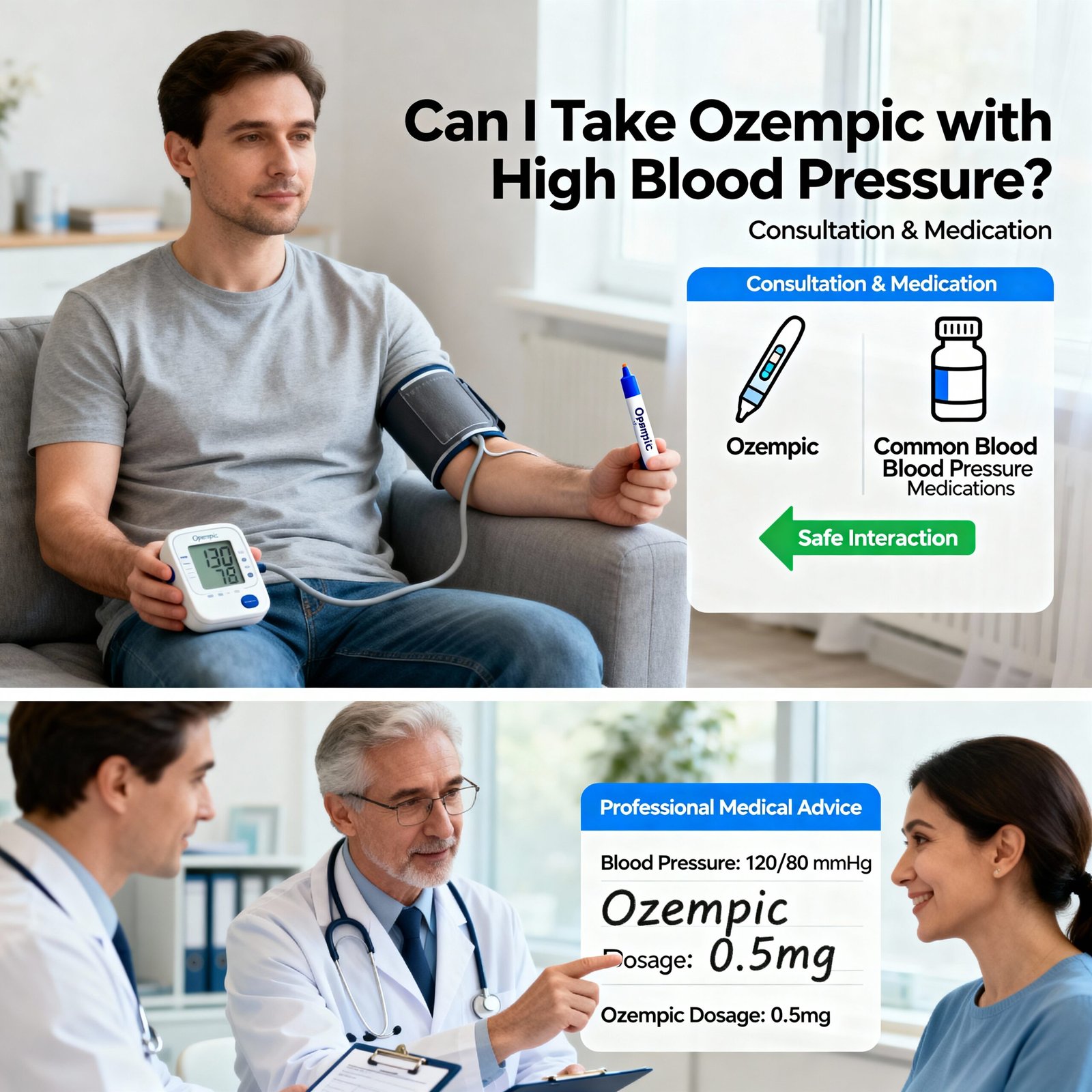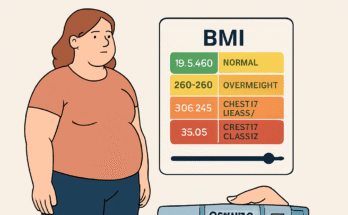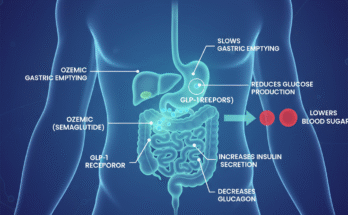Managing type 2 diabetes alongside hypertension presents unique challenges for millions of Americans. If you’re among the many patients navigating both conditions, you’ve likely wondered about the safety of newer diabetes medications like Ozempic. Understanding the relationship between semaglutide effects on blood pressure and cardiovascular health is crucial for making informed treatment decisions.
Understanding Ozempic and Hypertension Safety
Ozempic (semaglutide) belongs to a class of medications called GLP-1 receptor agonists, designed primarily to improve blood sugar control in adults with type 2 diabetes. Most people with high blood pressure and diabetes can safely take Ozempic, making it a viable treatment option for patients managing both conditions simultaneously.
The question “Is Ozempic safe for heart patients?” has gained significant attention as prescription rates soar. Clinical evidence suggests that weight loss injections for hypertensive patients not only pose minimal risk but may offer unexpected cardiovascular benefits. This makes semaglutide particularly noteworthy in the landscape of diabetes management for those with existing cardiovascular concerns.
Does Ozempic Raise or Lower Blood Pressure?

One of the most common concerns patients express relates to how GLP-1 agonists and blood pressure control interact. Ozempic is more likely to lower blood pressure than to increase it, with several trials of semaglutide demonstrating this effect. Studies have shown that blood pressure typically goes down in people treated with Ozempic and similar medications.
However, it’s essential to understand that Ozempic is not FDA-approved for treating hypertension. While blood pressure reductions are a welcome secondary benefit, healthcare providers prescribe Ozempic primarily for type 2 diabetes management and sometimes off-label for weight management in patients with obesity.
The mechanism behind these blood pressure improvements appears multifaceted. Weight loss contributes significantly to blood pressure reduction, but research suggests semaglutide may have direct cardiovascular effects independent of weight loss. This dual action makes Ozempic particularly valuable for diabetics with high blood pressure who can use this medication effectively.
Ozempic Cardiovascular Side Effects and Benefits
When evaluating Ozempic contraindications for hypertension, it’s important to distinguish between common side effects and serious cardiovascular concerns. The most frequently reported side effects include gastrointestinal symptoms such as nausea, vomiting, and diarrhea. These typically subside as your body adjusts to the medication.
Regarding cardiovascular safety, the evidence is reassuring. The landmark SUSTAIN 6 trial provided crucial data about semaglutide’s cardiovascular profile. In SUSTAIN 6, involving patients at high risk of cardiovascular disease, semaglutide significantly decreased the occurrence of cardiovascular events compared with placebo. This cardiovascular outcomes trial demonstrated that Ozempic not only poses no additional heart risk but may actively protect against major adverse cardiovascular events.
Ozempic is indicated to reduce the risk of major adverse cardiovascular events including CV death, nonfatal myocardial infarction, and nonfatal stroke in adults with type 2 diabetes and established cardiovascular disease. This FDA indication represents a significant advancement in diabetes care, particularly for patients concerned about Ozempic and heart disease risks.
The SELECT trial further expanded our understanding by examining semaglutide in patients with obesity and cardiovascular disease but without diabetes. In patients with preexisting cardiovascular disease and overweight or obesity but without diabetes, weekly subcutaneous semaglutide at a dose of 2.4 mg was superior to placebo in reducing the incidence of death from cardiovascular causes, nonfatal myocardial infarction, or nonfatal stroke.
Managing Diabetes with Hypertension: The Ozempic Advantage
For patients managing type 2 diabetes and blood pressure concerns simultaneously, Ozempic offers several advantages. The medication addresses multiple risk factors concurrently: improving glycemic control, facilitating weight loss, and potentially reducing blood pressure. This multifaceted approach simplifies treatment regimens and may improve medication adherence.
Many patients have reported improvements in blood pressure levels, with reductions in both systolic and diastolic readings, with this improvement likely linked to significant weight loss. The weight loss component deserves special attention, as obesity independently contributes to both diabetes and hypertension. By addressing excess body weight, semaglutide tackles a fundamental contributor to both conditions.
Ozempic Blood Pressure Medication Interactions
Understanding potential interactions between Ozempic and common antihypertensive medications is crucial for safe treatment. Fortunately, semaglutide generally demonstrates good compatibility with standard blood pressure medications.
ACE Inhibitors with Ozempic: ACE inhibitors remain a cornerstone of hypertension management, particularly in diabetic patients, due to their kidney-protective effects. No significant contraindications exist between ACE inhibitors and semaglutide, and many patients successfully take both medications concurrently.
Beta Blockers and Ozempic Interaction: Beta blockers are frequently prescribed for hypertension and heart conditions. These medications can be safely combined with Ozempic in most cases. However, patients should monitor for hypoglycemia more carefully, as beta blockers can mask some warning signs of low blood sugar.
Diuretics and GLP-1 Receptor Agonists: Diuretics help manage blood pressure by reducing fluid retention. When starting Ozempic alongside diuretics, be aware that the gastrointestinal side effects of semaglutide (particularly diarrhea and vomiting) could lead to dehydration. Maintaining adequate hydration becomes especially important with this combination.
Your healthcare provider may need to adjust dosages of existing blood pressure medications after starting Ozempic, particularly if you experience significant weight loss or blood pressure reductions. Regular monitoring ensures optimal dosing of all medications.
Ozempic Dosage for Blood Pressure Patients
The standard Ozempic dosage protocol doesn’t differ based on hypertension status. Treatment typically begins with 0.25 mg once weekly for four weeks as a starter dose to minimize gastrointestinal side effects. After this initiation period, the dose increases to 0.5 mg weekly.
For patients requiring additional glycemic control, the dose may be increased to 1 mg weekly after at least four weeks on the 0.5 mg dose. Some patients may eventually be prescribed the 2 mg weekly dose based on their individual needs and tolerance.
Having high blood pressure doesn’t necessitate dosage adjustments, but it does underscore the importance of regular cardiovascular monitoring. Your healthcare provider will want to track your blood pressure readings throughout treatment to document any improvements and adjust other medications accordingly.
Ozempic Prescription with High Blood Pressure: What to Expect
Getting Ozempic approved with cardiovascular conditions involves several steps. Your healthcare provider will conduct a comprehensive evaluation, including:
Medical History Review: Expect detailed questions about your cardiovascular history, including any history of heart attack, stroke, or heart failure. Your provider needs complete information about Ozempic, kidney disease high blood pressure connections, as kidney function significantly impacts treatment decisions.
Current Medication Assessment: Bring a complete list of all medications, including over-the-counter drugs and supplements. This helps identify potential interactions and optimize your treatment plan.
Baseline Testing: Before starting Ozempic, your provider typically orders baseline tests, including A1C, kidney function tests, and blood pressure measurements. These establish a starting point for tracking your progress.
Insurance Considerations: Many patients search for an Ozempic coupon for heart condition patients to manage costs. The manufacturer offers savings programs, and some insurance plans cover Ozempic for FDA-approved indications, including cardiovascular risk reduction in appropriate patients.
Special Considerations: Ozempic Stroke Risk Hypertension
While hypertension is a known risk factor for stroke, the evidence suggests Ozempic may actually reduce stroke risk rather than increase it. The SUSTAIN 6 trial data showed reductions in nonfatal stroke among semaglutide users compared to placebo. However, patients with a history of stroke or transient ischemic attack should discuss their complete medical history with their healthcare provider before starting treatment.
Ozempic and Kidney Disease with High Blood Pressure
The combination of diabetes, hypertension, and kidney disease creates complex treatment considerations. Chronic kidney disease affects medication dosing and clearance, and kidney function must be carefully monitored in patients taking Ozempic. While semaglutide has demonstrated some kidney-protective effects in clinical trials, patients with advanced kidney disease require specialized care and may need dosage adjustments or alternative treatments.
Comparing Alternatives: Is Ozempic Right for You?
Mounjaro vs Ozempic for Hypertensive Patients: Mounjaro (tirzepatide) represents a newer dual GIP/GLP-1 receptor agonist. Both medications show promise for patients with hypertension, though Mounjaro has demonstrated more substantial weight loss in head-to-head trials. The choice between them depends on individual factors, including insurance coverage, side effect profile, and treatment goals.
Wegovy and High Blood Pressure Safety: Wegovy contains the same active ingredient as Ozempic (semaglutide) but at a higher dose specifically approved for weight management. For patients whose primary concern is weight loss with secondary benefits for blood pressure and diabetes, Wegovy might be appropriate.
Trulicity Cardiovascular Effects Comparison: Trulicity (dulaglutide) is another GLP-1 receptor agonist with proven cardiovascular benefits. It offers once-weekly dosing similar to Ozempic, and some patients prefer its auto-injector design.
Rybelsus Blood Pressure Concerns: Rybelsus offers oral semaglutide as an alternative to injections. While it contains the same active ingredient, the oral formulation has different absorption characteristics and may not be ideal for all patients with cardiovascular concerns.
Victoza Hypertension Compatibility: Victoza (liraglutide) was the first GLP-1 receptor agonist to demonstrate cardiovascular benefits. It requires daily rather than weekly injection, which some patients find inconvenient, but it remains a valid option with established cardiovascular safety data.
FDA Warnings and Official Safety Information
Novo Nordisk Ozempic blood pressure studies continue to expand our understanding of semaglutide’s cardiovascular effects. The Ozempic package insert hypertension information provides comprehensive safety data, including contraindications and warnings. Key points from Ozempic FDA warnings cardiovascular include:
- A boxed warning about thyroid C-cell tumors observed in animal studies (though relevance to humans remains unclear)
- Contraindication in patients with a personal or family history of medullary thyroid carcinoma
- Contraindication in patients with Multiple Endocrine Neoplasia syndrome type 2
- Warnings about pancreatitis, diabetic retinopathy complications, and acute kidney injury
The Ozempic official safety information, the hypertension section notes that semaglutide is generally well-tolerated in patients with high blood pressure, but all patients should be monitored for adverse effects.
Managing Hypertension While on Ozempic: Practical Tips
Successfully managing hypertension while on Ozempic requires a comprehensive approach:
Monitor Blood Pressure Regularly: Track your readings at home and share them with your healthcare provider. This helps identify trends and guides medication adjustments.
Stay Hydrated: Given Ozempic’s gastrointestinal side effects, maintaining adequate hydration becomes crucial, especially if you’re taking diuretics.
Follow a Heart-Healthy Diet: Combine Ozempic treatment with dietary modifications that support both blood pressure control and blood sugar management. Reduce sodium intake, increase potassium-rich foods, and focus on whole grains, lean proteins, and vegetables.
Exercise Regularly: Physical activity enhances Ozempic’s effects on weight loss and provides independent cardiovascular benefits. Aim for at least 150 minutes of moderate-intensity activity weekly.
Medication Compliance: Take all prescribed medications consistently. Some patients find that success reduces their need for blood pressure medications, but never adjust doses without consulting their healthcare provider.
Conclusion: Can Diabetics with High Blood Pressure Use Ozempic?
The evidence overwhelmingly supports the safe use of Ozempic in diabetics with high blood pressure. Not only is semaglutide contraindicated in rare cases, but the medication may offer cardiovascular benefits that extend beyond glycemic control. The combination of improved blood sugar management, weight loss, and potential blood pressure reduction makes Ozempic a valuable tool for patients managing multiple metabolic conditions.
However, individual patient factors matter tremendously. What blood pressure medications interact with Ozempic? Your overall cardiovascular risk profile, kidney function, and treatment goals all influence whether Ozempic represents the optimal choice for you. An alternative to Ozempic for hypertensive patients might be more appropriate depending on these factors.
The key to success lies in comprehensive care that addresses all aspects of your health. Work closely with your healthcare provider to develop a treatment plan that considers your diabetes, hypertension, and overall cardiovascular health. Regular monitoring, lifestyle modifications, and appropriate medication management create the foundation for optimal outcomes.
If you’re considering Ozempic weight loss high blood pressure combination therapy, schedule a thorough consultation with your healthcare provider. They can review the latest Ozempic clinical trials’ cardiovascular outcomes data and help you determine whether semaglutide fits into your personalized treatment plan. With proper medical supervision, many patients successfully manage both diabetes and hypertension while achieving significant health improvements through this innovative medication.ImproveExplain
/isolated-segment.html?v=8682adb37bimprove their overall health while maintaining excellent blood pressure control.

Jake Morrison is a health journalist and certified medical researcher who specializes in obesity treatment and diabetes care. With a background in biomedical science and years spent analyzing real-world outcomes of GLP-1 therapies like Ozempic, Jake brings an evidence-driven, reader-friendly approach to complex medical topics.




